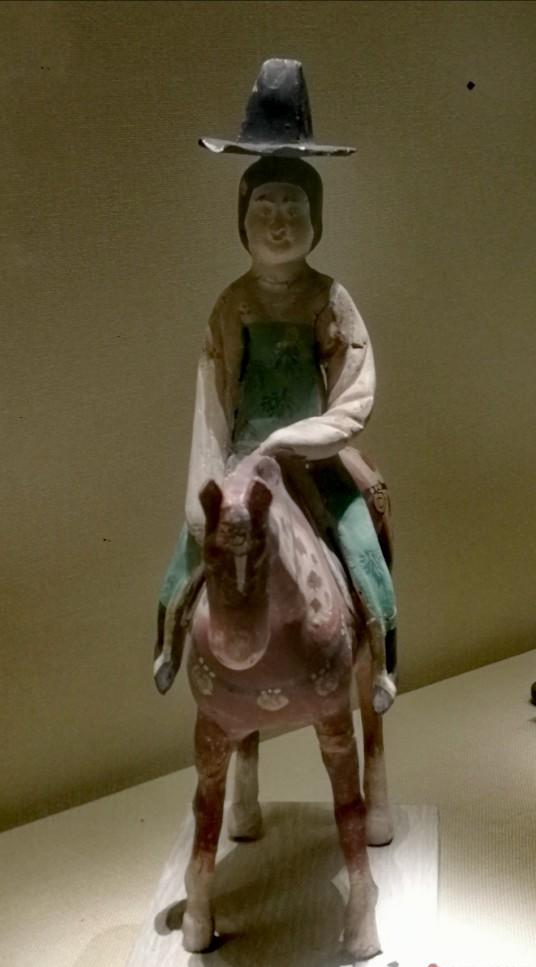ShiLiuyun/Xinjiang Daily reporter Jia Chunxia
In the Xinjiang Historical Relics Exhibition Hall on the first floor of the Xinjiang Museum, a figurine of a horsewoman wearing a veiled hat attracted many spectators. The woman wears a high bun, wears a square tapered black top hat, a plump face, a cherry mouth, a lightly drawn eyebrow, a thin grease powder, an orange round neck short sleeves, a blue-brown vertical striped loose trousers, black leather boots, a heroic posture, sitting on a brown horse.

Front view of the female figure riding a horse wearing a hood. Pomegranate Cloud/ Xinjiang Daily reporter Jia Chunxia photo
"This figurine was unearthed from the Tang Dynasty tombs of the Astana Ancient Tomb Group in Turpan, when two female figurines wearing veiled hats were excavated. Their discovery not only reflects the full implementation of the Tang Dynasty's decrees in the Gaochang area at that time, but also shows that the Gaochang area had the same popular fashion as Chang'an during the Tang Dynasty. Nie Mengyao, a docent at the Xinjiang Museum, introduced that in the Tang Dynasty, as the heyday of China's feudal society, women living at that time had great freedom and could show their faces like men to play, listen to plays and watch balls in the suburbs.
Horseback riding was one of the leisure lifestyles of aristocratic women in the Tang Dynasty. This figurine of a horsewoman wearing a hood shows the standard attire of Tang Dynasty women riding a horse: in addition to a hood, there are boots, trousers, narrow-sleeved short shirts and other costumes, so that people can more three-dimensionally and intuitively appreciate the spiritual outlook of Women in the Tang Dynasty and the atmosphere of the Tang Dynasty.
"Wearing boots is easy to ride, and stepping on the horse does not grind the feet, so it has become a necessary equipment for horseback riding." Nie Mengyao said that because wearing a skirt is not convenient for stirrup riding, women wear pants like men, and clean trousers and narrow-sleeved short shirts are popular.
Side view of a horsewoman wearing a hood. Pomegranate Cloud/ Xinjiang Daily reporter Jia Chunxia photo
The drapery hat was originally a hat used by the nomadic people living in the northwest to go out for wind protection, and the main body was made of a kind of hard rattan or mat as a skeleton, which was bandaged with cloth and then embellished with a gauze net along the edge, which grew to the neck to cover the face. After spreading to the Central Plains, it became a fashionable dress for aristocratic women to travel. According to historical records, this kind of drapery hat was popular during the Wu Zetian period, "(Wu) Zetian, the drapery hat was popular". The fashion of women in the upper class of the Central Plains Dynasty to travel and wear veiled hats, which in turn affected the women of the upper class society in Turpan at that time.
The turpan region has a hot climate and often has wind and sand, so tang dynasty craftsmen created such a figurine close to actual life according to the dress of local people when they went out. The horsewoman figurines wear gorgeous spring costumes, telling people that it is the time of the wind and the sun and the spring is bright. The sculpture of the horse on which the woman rides is particularly ingenious, with black, yellow and white colors depicting mud, knotted heads, Danglu, apricot leaves and other ornaments, and the horse's body is plump and fleshy, reflecting the superb skills of Turpan craftsmen at that time.
Spectators watched the figurines of horsemen in hoods. Pomegranate Cloud/ Xinjiang Daily reporter Jia Chunxia photo
How was this beautiful figurine of a horseman in a hood made? Nie Mengyao said that thanks to Xinjiang's unique dry climate, the figurine and the town tomb beast unearthed from the Astana tomb group are the same production method, that is, the craftsmen first use mud to knead the shape, and then use pure natural plant dyes to color, directly air dry and dry, without firing.